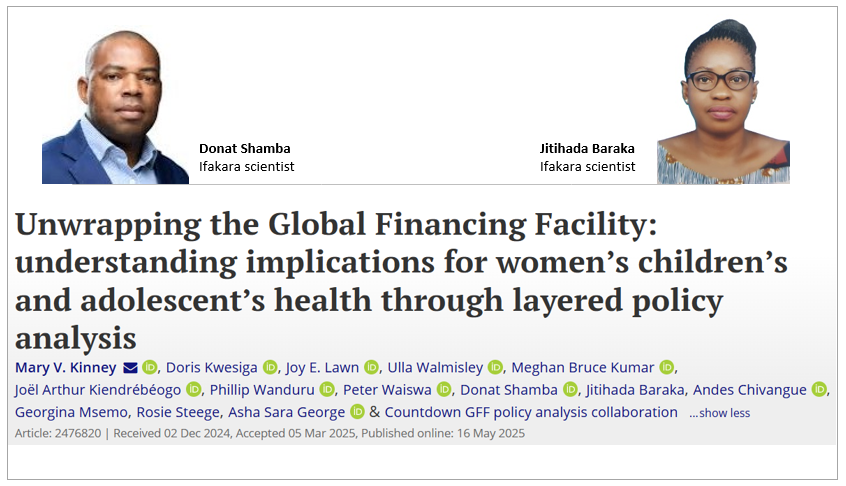
REVIEW: Global health fund for women and children is making strides, but gaps remain

A new analysis published on Global Health Action has found that the Global Financing Facility (GFF), a global health initiative focused on improving the health of women, children, and adolescents, is making meaningful contributions but still faces challenges in meeting its full potential.
What is the GFF?
Established in 2015, the Global Financing Facility (GFF) was the first global health initiative (GHI) focused specifically on reproductive, maternal, newborn, child, and adolescent health and nutrition (RMNCAH-N).
Driven by the recognition that traditional aid and government funding were insufficient to meet the health needs of these groups, the GFF was created to support countries to develop country-led investment cases, to improve coordination of partners working on RMNCAH-N, to reform health systems and financing mechanisms, and to mobilize and align domestic resources, external financing, and private investments.
Key contributions, challenges of GFF
Since its establishment, the GFF has shown progress, however, the initiative continues to face obstacles. While progress in transparency and data use is evident, accountability gaps, power imbalances, and limited engagement with civil society and the private sector still hinder national ownership.
To examine these issues more closely, the Countdown to 2030 Health Policy and Systems Group brought together a diverse team of academics, activists, and implementers, primarily based in Africa, to evaluate the GFF's policy processes.
Ifakara scientists among contributors
Donat Shamba, a Senior Research Scientist at Ifakara Health Institute, and Jitihada Baraka, also a Research Scientist, contributed to the analysis alongside colleagues. Their work involved reviewing GFF documents from 28 countries, with an in-depth focus on policy processes in four—Burkina Faso, Mozambique, Tanzania, and Uganda.
Notable findings show that while the GFF helped unlock more than $595 million in funding, which leveraged an additional $14.5 billion through World Bank projects, much of these funds did not align with the priorities laid out in country-led investment cases.
Mismatch between plans and projects
Further findings show many countries prioritized maternal, newborn, and adolescent health in their investment plans. However, funded projects often did not reflect those focus areas. Key areas like community health and quality of care received less attention, and in some cases, project documents failed to align with national health strategies, raising concerns about how priorities are set and implemented.
Limited inclusion, weak transparency
Despite GFF’s model being based on the principle of country-led planning, the analysis found that decision-making was often dominated by technocrats, with limited involvement from stakeholders from civil society organizations or the private sector. This lack of inclusiveness was especially evident in African countries, where local engagement is essential for context-appropriate health interventions.
"This multi-layered study showed that the World Bank, GFF, and Ministries of Health held the most power through primarily technocratically-led processes. The technical nature of documents in some instances made the GFF policy processes inaccessible to civil society and development partners alike," noted the authors.
Power imbalances influence outcomes
A central issue identified by researchers is the unequal balance of power between donors, particularly the World Bank, and national governments. While ministries of health led planning efforts on paper, in practice, they were often influenced or constrained by donor preferences and priorities. In some cases, this made it difficult for countries to fully “own” their health agendas, especially when serving marginalized communities.
"Donor influence has been noted elsewhere in policy formulation, as has power imbalance between actors. The perceived and observed link between GFF and the World Bank likely had its advantages and disadvantages for the GFF’s ability to convene, but importantly, it demonstrates the power imbalance that donors, such as the World Bank, have in influencing national priorities," the authors underlined.
Need for stronger monitoring and learning
The researchers call for better systems to track health progress and ensure that resources are used effectively. In particular, they emphasize the need for clearer and more inclusive decision-making processes that involve all relevant stakeholders.
"Global Health Initiatives need to be held accountable for their commitments and ensure that a country-led approach is accompanied by transparent processes at every step in the policy process, with broad stakeholder engagement and agreed national priorities," the authors noted.
Moreover, they underscored that, as the GFF moves into its next phase, ongoing research and evaluation will be essential to measure its catalytic impact in improving the health of women, adolescents, and children in line with its transformative goals.
Read the publication here.
